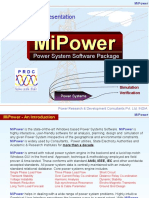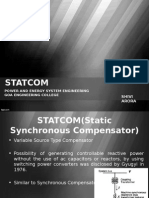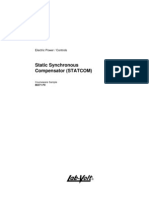Statcom With Pod Controller For Reactive Power Compensation
Uploaded by
nidhiStatcom With Pod Controller For Reactive Power Compensation
Uploaded by
nidhiSTATCOM WITH POD CONTROLLER FOR REACTIVE POWER
COMPENSATION
Vijai Jairaj1, Vishnu.J2and Sreenath.N.R3
1
PG Student [Electrical Machines], Department of EEE, Sree Buddha College of Engineering
Pattoor, Kerala, India
2
Assistant professor, Department of EEE, Sree Buddha College of Engineering Pattoor, Kerala,
India
3
PG Student3 [Electrical Machines], Department of EEE, Sree Buddha College of Engineering
Pattoor, Kerala, India
Abstract – The main problem faced by the industrial and commercial load is the power quality issues
during the fault. This is an undesirable phenomenon. The main aim is to introduce STATCOM as a solution
for reactive power. It is connected in shunt for necessary compensation on its load side. To remove the
power quality problems it should be compensated by injecting a current so that it can provide necessary
compensation. For that purpose we are using reactive power compensative devices (FACTS devices).
Among the FACTS devices STATCOM is more preferred. It consists of a voltage source inverter (VSI).
The shunt VSI is connected via a DC link, which includes a DC capacitor. The modeling of Transmission
line is completed using MATLAB SIMULINK. At that time active power is reduced and power quality
problems will dominate. This problem can be eliminated by placing a STATCOM which will supply
shortage of reactive power. This paper utilizes a POD Controller for providing necessary control and thus
for mitigation of power quality problems and hence reactive power compensation can be done which is the
main objective.
Keywords- FACTS, STATCOM, VSI, POD
I. INTRODUCTION
Voltage control is one of the most important aspects in the Transmission line. The main problem
with transmission line is its voltage sag during the fault which is harmful for the equipments connected to
the line. So it is necessary to compensate such voltage variations. When a fault occurs there will be a sudden
dip in voltage at that. This is an undesired phenomenon, can be solved using reactive power compensation
devices like FACTS devices. The shunt devices which can be used for reactive compensation are SVC and
STATCOM. A Static Var compensator (SVC) is a fast acting shunt device which will regulate voltage,
reduce harmonics and stabilize the system. It is also connected near industrial loads to improve power
quality. But STATCOM is more preferred than SVC because it provides more reactive power support at low
voltages. Dc link capacitor will act as a source for compensation.
Different types of controller can be employed. They are proportional controller, proportional plus
integral controller. proportional plus integral plus derivative controller and power oscillation damping
controller. The STATCOM is additionally equipped with a Power Oscillation Damping (POD) control
function. The controller parameters are optimized using parameter identification.
Design of current and voltage controllers has a significant role in modeling of STATCOM. The
STATCOM is applied with the DC link voltage with the help of designed controllers and depending on
spikes and overshoot responses a suitable DC link voltage is applied. Based on the values of DC link
voltage passive components are designed [1].
There are large number of sub modules which are connected in series to build up a controllable
voltage source in a multi-level converter technology. It reduces the number of harmonics generated
compared to SVC devices and also there is no need to install additional fixed harmonic filter bank at
@IJMTER-2016, All rights Reserved 147
International Journal of Modern Trends in Engineering and Research (IJMTER)
Volume 03, Issue 06, [June– 2016] ISSN (Online):2349–9745; ISSN (Print):2393-8161
substation which is the main advantage of multi-level converter technology over redundant modular
converter design [2].
The UPFC system has many advantages like it has the ability to control both real and reactive power
phase angle and reduced maintenance. [3] Shows the ability of UPFC to control both real and reactive
power. With increase in real and reactive power there will be an increase in angle of injection. It explains
how power quality can be improved by the control and performance of UPFC.
This paper utilizes a model of STATCOM to study about stability phenomenon and the performance
of power system. The STATCOM is equipped with a Power Oscillation Damping (POD) control function.
Parameter identification is used for optimization of controller parameters.
II. STATCOM
STATCOM consist of a shunt converter with a dc storage capacitor which is used for compensation.
It will inject current to the transmission line thus it can provide necessary compensation.
Fig.1. STATCOM single line diagram
The major power quality issues [7] faced by domestic and commercial loads are voltage sag and
swell. About 80 % of power quality issues is due to this phenomenon. According to definition, Voltage sag
is the reduction in the AC rms voltage from half of a cycle at power frequency to a few seconds duration.
Similarly Voltage swell is the increase in the rms AC voltage at power frequency from half cycles to a few
seconds.
In this paper, STATCOM is based on three phase voltage source converter. It produces both
capacitive and inductive reactive power internally. By controlling the gate pulses of inverter switches are
being controlled, this voltage source can modify the compensating reactive power and making voltage
smooth. So, by injecting reactive power voltage sag can be mitigated and by absorbing reactive power
voltage swell can be improved.
Fig. 2 shows the three basic operation modes of the STATCOM output current, I, which depends on
varying values of Vi. If Vi = Vs, the reactive power is zero and at that time it does not absorb or supply
reactive power. The STATCOM exhibits a capacitive reactance, when the injecting voltage (Vi) is greater
than the supply voltage (Vs), and it is said to be in capacitive mode of operation. Hence in this mode, the
device supplies capacitive reactive power to the ac system. On the contrary, when the supply voltage (Vs) is
greater than the injecting voltage (Vi), the STATCOM exhibits inductive reactance and hence it is in the
inductive mode of operation. In this mode, the device absorbs inductive reactive power from the ac system.
Fig.2. Basic modes of operation of STATCOM
@IJMTER-2016, All rights Reserved 148
International Journal of Modern Trends in Engineering and Research (IJMTER)
Volume 03, Issue 06, [June– 2016] ISSN (Online):2349–9745; ISSN (Print):2393-8161
III. POD CONTROLLER
Fig.3. POD controller
A POD controller is developed and is tuned to provide an additional damping to stabilize the
power system after severe disturbances. The STATCOM controller parameters are shown in Table 1. The
POD controller constitutes a transfer function which is composed of a transducer with a gain which is
followed by a washout filter. The signal obtained at the output is limited. The transfer function which
constitutes lead-lag filters which can be used for phase compensation of POD controllers
Table.1. POD Parameters
PARAMETER VALUE UNIT
K 1.1008 PU
T1 0..064 Sec
T2 0.145 Sec
T3 0.345 Sec
IV. Modeling of transmission Line
Fig.4. transmission line model
The above figure shows the modelling of transmission line in MATLAB/SIMULINK. A 3 phase
source provides which is generally a generator provides the supply for transmission line the input voltage
will be 11kV and in order to transmit it need to be step-up, step-up transformer is used here. The voltage is
stepped up to a desired voltage and a RL load is connected as load this is modelled to know the variation of
voltage with respect to fault which is applied on the load side.
V. MODELLING OF TRANSMISSION LINE WITH STATCOM
The figure shows the modelling of transmission line with STATCOM. STATCOM consist of
voltage source converter with a DC link capacitor. It will inject current to the line to provide necessary
compensation [2]. There is a controller provided to control the firing of Voltage source converter.
@IJMTER-2016, All rights Reserved 149
International Journal of Modern Trends in Engineering and Research (IJMTER)
Volume 03, Issue 06, [June– 2016] ISSN (Online):2349–9745; ISSN (Print):2393-8161
Fig.5. Modeling of transmission line with STATCOM
STATCOM is an important device among FACTS family. It is connected in shunt with transmission
line, also it has a superior performance in lot of aspects such as fast responding speed, voltage stabilization,
power loss is reduced and it also limits the transient voltage.
Fig.6. Modeling of STATCOM
VI. PWM Generator
Fig.7. PWM Generator
The PWM generator generates the gate pulses for the IGBTs of the VSC. Here, the sine and the
triangular waveforms are generated. The sine wave which is of 50Hz is compared with the triangular wave
of 20 kHz. Thus on comparison, the PWM pulses are produced and these pulses are given to gates of the
IGBTs. . Modulation index is defined as the ratio of the magnitude of modulating wave to carrier wave. By
varying the modulation index, the magnitude of the converter output will vary and as well as by varying the
phase angle of the modulating wave, the converter output voltage phase angle will also vary.
@IJMTER-2016, All rights Reserved 150
International Journal of Modern Trends in Engineering and Research (IJMTER)
Volume 03, Issue 06, [June– 2016] ISSN (Online):2349–9745; ISSN (Print):2393-8161
VII. RESULT
A transmission system is modeled using MATLAB/ SIMULINK software. A fault is applied and it
has a resistance of 0.1 ohm and fault transition time between 0.05 and 0.1sec .During the time of fault
voltage sag will occur and there will be a decrease in active power and increase in reactive power during
this time. Results obtained during the simulation shown below so we need to compensate this by using a
STATCOM so the voltage can be improved and the power is also improved. Here for better understanding
simulation time is taken as 0.7. From the voltage waveform at instant of fault STATCOM will inject current
in to the system and thus necessary compensation occurs.
Fig.8. Voltage without STATCOM
Fig.9. Active power without STATCOM
Fig.10. Reactive power without STATCOM
@IJMTER-2016, All rights Reserved 151
International Journal of Modern Trends in Engineering and Research (IJMTER)
Volume 03, Issue 06, [June– 2016] ISSN (Online):2349–9745; ISSN (Print):2393-8161
Fig.11. Voltage with STATCOM
VIII. CONCLUSION
Fault is one of the problems faced by power system. During fault the voltage will decrease and there
is a sudden increase in reactive power so we need to compensate this using STATCOM which will inject
current in to the system and hence necessary compensation can be obtained. A POD controller is used for
controlling the gate pulse of IGBT. Thus by POD controller serves a major role in improving power quality.
Hence the compensation is done with STATCOM in SIMULINK platform.
REFERENCES
[1] S.K.Sethy, J.K.Moharana “Design, Analysis and Simulation of Linear Model of a STATCOM for Reactive Power
Compensation with Variation of DC-link Voltage” International Journal of Engineering and Innovative Technology (IJEIT)
Volume 2, Issue 5, November 2012
[2] M. Pereira, D. Retzmann, J. Lottes, M. Wiesinger, G. Wong, “SVC PLUS: An MMC STATCOM for network and grid
access applications”, IEEE PowerTech Conference, Trondheim, Norway, 2011
[3] Parvej khan, Himmat singh” Power Flow Control In A Transmission Line Through UPFC” International Journal of Emerging
Technology and Advanced Engineering Website: www.ijetae.com (ISSN 2250-2459, ISO 9001:2008 Certified Journal,
Volume 2, Issue 12, December 2012)
[4] M. Rama Sekhara Reddy and M.Vijaya Kumar. "Power Quality Improvement in DFIG based Wind Energy Conversion
System using UPFC." IOSR Journal of Engineering (IOSRJEN), vol. 3, no. 1, pp. 46-54, Jan. 2013.
[5] S.Divya, U.Shyamala, Power Quality Improvement In Transmission Systems Using DPFC” IEEE sponsored 2nd
international conference on electronics and communication system (icecs 2015).
[6] Ch.Chengaiah, R.V.S.Satyanarayana” power flow assesment in transmission lines using simulink model with upfc” 2012
International Conference on Computing, Electronics and Electrical Technologies [ICCEET].
[7] R. C. Dugan, M. F. McGranaghan and H. W. Beaty,―Electric Power Systems Quality.‖ 2nd Edition, McGraw Hill, New
York, 2006.
@IJMTER-2016, All rights Reserved 152
You might also like
- New England Reduced Model (39 Bus System) MATLAB Study Report50% (2)New England Reduced Model (39 Bus System) MATLAB Study Report23 pages
- A Transfer Function Approach To Harmonic Filter DesignNo ratings yetA Transfer Function Approach To Harmonic Filter Design15 pages
- Vertical Vapor Liquid Separator Sizing: Chemical Engineering CalculationsNo ratings yetVertical Vapor Liquid Separator Sizing: Chemical Engineering Calculations8 pages
- The Philippines, A Singular and A Plural Place PDFNo ratings yetThe Philippines, A Singular and A Plural Place PDF184 pages
- Simulation of Some Power System, Control System and Power Electronics Case Studies Using Matlab and PowerWorld SimulatorFrom EverandSimulation of Some Power System, Control System and Power Electronics Case Studies Using Matlab and PowerWorld SimulatorNo ratings yet
- A Case Study for a Single-Phase Inverter Photovoltaic System of a Three-Bedroom Apartment Located in Alexandria, Egypt: building industry, #0From EverandA Case Study for a Single-Phase Inverter Photovoltaic System of a Three-Bedroom Apartment Located in Alexandria, Egypt: building industry, #0No ratings yet
- Operation of A DSTATCOM in Voltage Control ModeNo ratings yetOperation of A DSTATCOM in Voltage Control Mode7 pages
- Control of HVDC Transmission System Based On MMCNo ratings yetControl of HVDC Transmission System Based On MMC22 pages
- Wind Turbine Efficiency and Grid Code Requirements: Dr. Arshad Ali Assistant Professor100% (1)Wind Turbine Efficiency and Grid Code Requirements: Dr. Arshad Ali Assistant Professor35 pages
- Institute of Engineering: Tribhuvan University100% (1)Institute of Engineering: Tribhuvan University14 pages
- Double Stage Single Phase Hybrid Stand Alone Solar Inverter: A Project ReportNo ratings yetDouble Stage Single Phase Hybrid Stand Alone Solar Inverter: A Project Report37 pages
- KE47503 High Voltage Chapter 7 - Measurement of High Volatges and Currents100% (1)KE47503 High Voltage Chapter 7 - Measurement of High Volatges and Currents53 pages
- Symmetrical Components Systems: I I I I I INo ratings yetSymmetrical Components Systems: I I I I I I6 pages
- A FACTS Device Distributed PowerFlow Controller (DPFC)No ratings yetA FACTS Device Distributed PowerFlow Controller (DPFC)8 pages
- Flexible Alternating Current Transmission System100% (1)Flexible Alternating Current Transmission System78 pages
- Non Sinusoidal Voltage - Non Sinusoidal Current Problem100% (1)Non Sinusoidal Voltage - Non Sinusoidal Current Problem3 pages
- Transient Stability Improvement of Power System Using Upfc100% (1)Transient Stability Improvement of Power System Using Upfc18 pages
- Generalized Theory of Electrical Machines-A Review: Dr. Sandip MehtaNo ratings yetGeneralized Theory of Electrical Machines-A Review: Dr. Sandip Mehta5 pages
- 00 SR Simulation of Motor and Control Based On MATLABNo ratings yet00 SR Simulation of Motor and Control Based On MATLAB98 pages
- Impact of Static Var Compensator (SVC) Installation in Power System StabilityNo ratings yetImpact of Static Var Compensator (SVC) Installation in Power System Stability7 pages
- AC-DC & DC-DC Converters For DC Motor Drives PDFNo ratings yetAC-DC & DC-DC Converters For DC Motor Drives PDF8 pages
- Unit Iv: Fundamentals of Harmonics: Fig.1: Current Distortion Caused by Nonlinear ResistanceNo ratings yetUnit Iv: Fundamentals of Harmonics: Fig.1: Current Distortion Caused by Nonlinear Resistance12 pages
- Determination of Critical Clearing Time in Transient Stability AnalysisNo ratings yetDetermination of Critical Clearing Time in Transient Stability Analysis5 pages
- ECE 8830 - Electric Drives: Topic 16: Control of SPM Synchronous Motor DrivesNo ratings yetECE 8830 - Electric Drives: Topic 16: Control of SPM Synchronous Motor Drives59 pages
- HVDC and FACTS Controllers - Applications of Static Converters in Power Systems by Vijay K. Sood100% (3)HVDC and FACTS Controllers - Applications of Static Converters in Power Systems by Vijay K. Sood33 pages
- "Voltage Stability Analysis of Multimachine System": Minor Project ReportNo ratings yet"Voltage Stability Analysis of Multimachine System": Minor Project Report27 pages
- Modeling of Power System in PSCAD/EMTDC Program100% (1)Modeling of Power System in PSCAD/EMTDC Program22 pages
- Power Loss Reduction by PV-PQ Buses ConversionNo ratings yetPower Loss Reduction by PV-PQ Buses Conversion70 pages
- Modeling and Testing of A Digital Differential Relay Using Matlab/SimulinkNo ratings yetModeling and Testing of A Digital Differential Relay Using Matlab/Simulink20 pages
- Table 1. Power Quality Problems and Their CausesNo ratings yetTable 1. Power Quality Problems and Their Causes27 pages
- Power Quality Enhancement Through Shunt Active Power Filter: Dr. A. S. Pandey Prof. A. K. SrivastavaNo ratings yetPower Quality Enhancement Through Shunt Active Power Filter: Dr. A. S. Pandey Prof. A. K. Srivastava44 pages
- BE IV Sem Hall Tickets Dec 2020-Pages-80-211No ratings yetBE IV Sem Hall Tickets Dec 2020-Pages-80-211132 pages
- Williams, Kenneth R. - The Natural Calculator (1991)100% (2)Williams, Kenneth R. - The Natural Calculator (1991)111 pages
- Training Plan - 101769488 - TP - 61084 - V1No ratings yetTraining Plan - 101769488 - TP - 61084 - V14 pages
- CRIMINAL TRIAL SERIES - An IntroductionNo ratings yetCRIMINAL TRIAL SERIES - An Introduction81 pages
- The Literary Translator and The Concept of FidelityNo ratings yetThe Literary Translator and The Concept of Fidelity16 pages
- NCERT Solutions For Class 12th Microeconomics - Chapter 3 - Production and Costs - AglaSem SchoolsNo ratings yetNCERT Solutions For Class 12th Microeconomics - Chapter 3 - Production and Costs - AglaSem Schools12 pages
- tc1972en-ed05_limits_and_dimensioning_for_omnipcx_office_rce_release_10.3No ratings yettc1972en-ed05_limits_and_dimensioning_for_omnipcx_office_rce_release_10.316 pages
- Research Methodology: Qudrattullah OmerkhelNo ratings yetResearch Methodology: Qudrattullah Omerkhel99 pages
- Download Complete The adventures of an IT leader Austin PDF for All Chapters100% (1)Download Complete The adventures of an IT leader Austin PDF for All Chapters55 pages
- Definition of Distribution Logistics From The Producer To The CustomerNo ratings yetDefinition of Distribution Logistics From The Producer To The Customer2 pages
- Barry Holloway v. Robert J. Tansy, 986 F.2d 1427, 10th Cir. (1993)No ratings yetBarry Holloway v. Robert J. Tansy, 986 F.2d 1427, 10th Cir. (1993)6 pages
- New England Reduced Model (39 Bus System) MATLAB Study ReportNew England Reduced Model (39 Bus System) MATLAB Study Report
- A Transfer Function Approach To Harmonic Filter DesignA Transfer Function Approach To Harmonic Filter Design
- Vertical Vapor Liquid Separator Sizing: Chemical Engineering CalculationsVertical Vapor Liquid Separator Sizing: Chemical Engineering Calculations
- The Philippines, A Singular and A Plural Place PDFThe Philippines, A Singular and A Plural Place PDF
- Simulation of Some Power System, Control System and Power Electronics Case Studies Using Matlab and PowerWorld SimulatorFrom EverandSimulation of Some Power System, Control System and Power Electronics Case Studies Using Matlab and PowerWorld Simulator
- A Case Study for a Single-Phase Inverter Photovoltaic System of a Three-Bedroom Apartment Located in Alexandria, Egypt: building industry, #0From EverandA Case Study for a Single-Phase Inverter Photovoltaic System of a Three-Bedroom Apartment Located in Alexandria, Egypt: building industry, #0
- Computer Methods in Power Systems Analysis with MATLABFrom EverandComputer Methods in Power Systems Analysis with MATLAB
- Wind Turbine Efficiency and Grid Code Requirements: Dr. Arshad Ali Assistant ProfessorWind Turbine Efficiency and Grid Code Requirements: Dr. Arshad Ali Assistant Professor
- Double Stage Single Phase Hybrid Stand Alone Solar Inverter: A Project ReportDouble Stage Single Phase Hybrid Stand Alone Solar Inverter: A Project Report
- KE47503 High Voltage Chapter 7 - Measurement of High Volatges and CurrentsKE47503 High Voltage Chapter 7 - Measurement of High Volatges and Currents
- A FACTS Device Distributed PowerFlow Controller (DPFC)A FACTS Device Distributed PowerFlow Controller (DPFC)
- Non Sinusoidal Voltage - Non Sinusoidal Current ProblemNon Sinusoidal Voltage - Non Sinusoidal Current Problem
- Transient Stability Improvement of Power System Using UpfcTransient Stability Improvement of Power System Using Upfc
- Generalized Theory of Electrical Machines-A Review: Dr. Sandip MehtaGeneralized Theory of Electrical Machines-A Review: Dr. Sandip Mehta
- 00 SR Simulation of Motor and Control Based On MATLAB00 SR Simulation of Motor and Control Based On MATLAB
- Impact of Static Var Compensator (SVC) Installation in Power System StabilityImpact of Static Var Compensator (SVC) Installation in Power System Stability
- Unit Iv: Fundamentals of Harmonics: Fig.1: Current Distortion Caused by Nonlinear ResistanceUnit Iv: Fundamentals of Harmonics: Fig.1: Current Distortion Caused by Nonlinear Resistance
- Determination of Critical Clearing Time in Transient Stability AnalysisDetermination of Critical Clearing Time in Transient Stability Analysis
- ECE 8830 - Electric Drives: Topic 16: Control of SPM Synchronous Motor DrivesECE 8830 - Electric Drives: Topic 16: Control of SPM Synchronous Motor Drives
- HVDC and FACTS Controllers - Applications of Static Converters in Power Systems by Vijay K. SoodHVDC and FACTS Controllers - Applications of Static Converters in Power Systems by Vijay K. Sood
- "Voltage Stability Analysis of Multimachine System": Minor Project Report"Voltage Stability Analysis of Multimachine System": Minor Project Report
- Modeling and Testing of A Digital Differential Relay Using Matlab/SimulinkModeling and Testing of A Digital Differential Relay Using Matlab/Simulink
- Power System Wide-area Stability Analysis and ControlFrom EverandPower System Wide-area Stability Analysis and Control
- Computer Aided Design of Electrical MachinesFrom EverandComputer Aided Design of Electrical Machines
- Power Quality Enhancement Through Shunt Active Power Filter: Dr. A. S. Pandey Prof. A. K. SrivastavaPower Quality Enhancement Through Shunt Active Power Filter: Dr. A. S. Pandey Prof. A. K. Srivastava
- Williams, Kenneth R. - The Natural Calculator (1991)Williams, Kenneth R. - The Natural Calculator (1991)
- The Literary Translator and The Concept of FidelityThe Literary Translator and The Concept of Fidelity
- NCERT Solutions For Class 12th Microeconomics - Chapter 3 - Production and Costs - AglaSem SchoolsNCERT Solutions For Class 12th Microeconomics - Chapter 3 - Production and Costs - AglaSem Schools
- tc1972en-ed05_limits_and_dimensioning_for_omnipcx_office_rce_release_10.3tc1972en-ed05_limits_and_dimensioning_for_omnipcx_office_rce_release_10.3
- Download Complete The adventures of an IT leader Austin PDF for All ChaptersDownload Complete The adventures of an IT leader Austin PDF for All Chapters
- Definition of Distribution Logistics From The Producer To The CustomerDefinition of Distribution Logistics From The Producer To The Customer
- Barry Holloway v. Robert J. Tansy, 986 F.2d 1427, 10th Cir. (1993)Barry Holloway v. Robert J. Tansy, 986 F.2d 1427, 10th Cir. (1993)





























































































